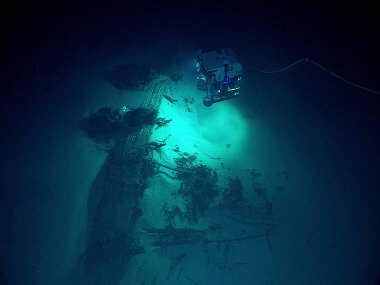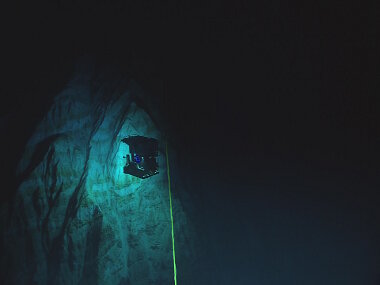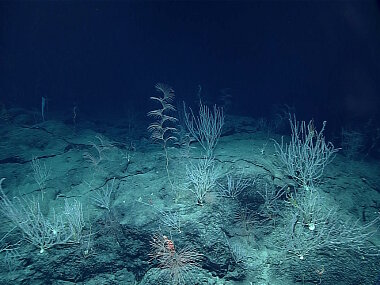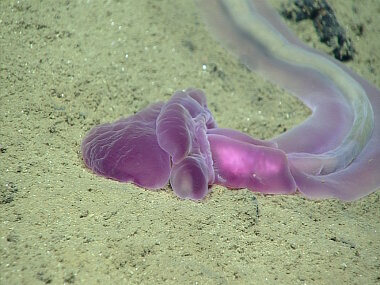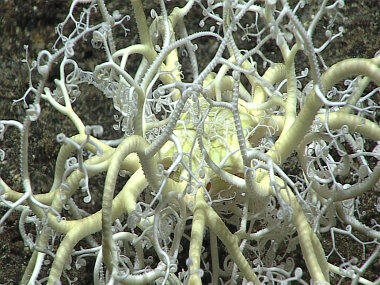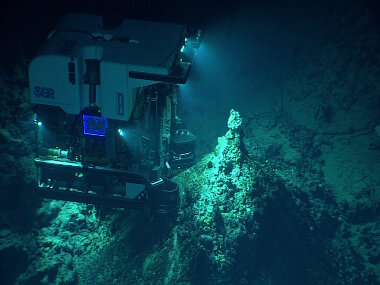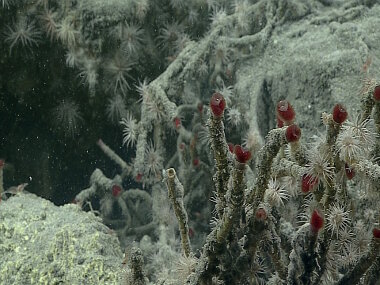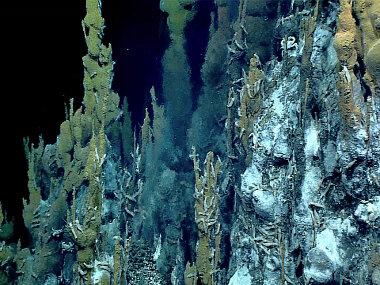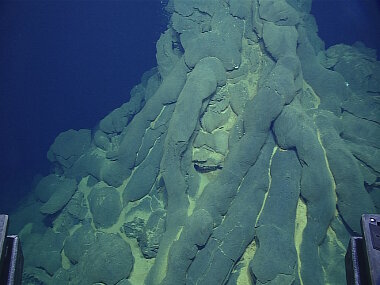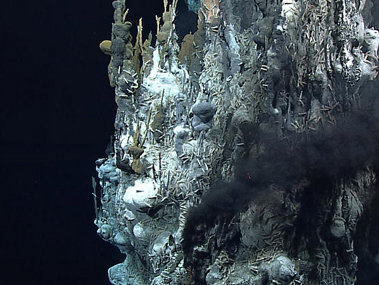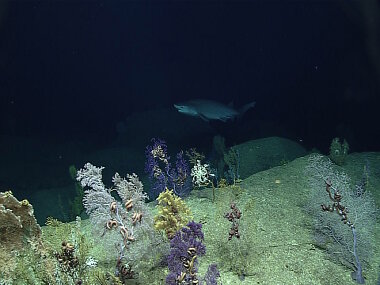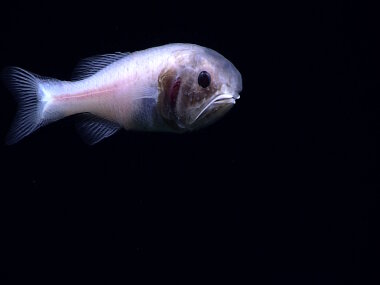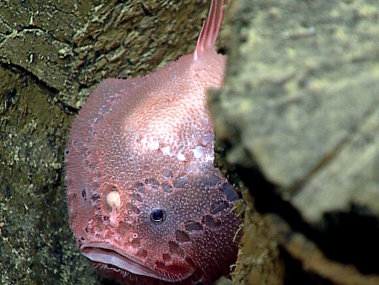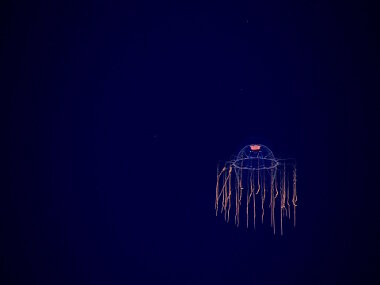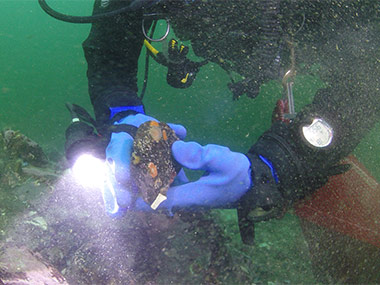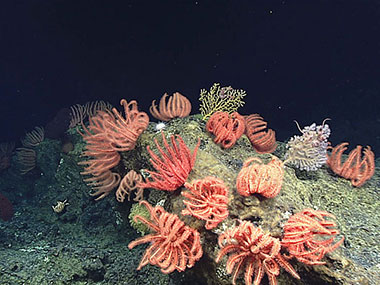Image Gallery
This page displays a limited number of images from expeditions recently led or supported by NOAA Ocean Exploration. To view images on a specific subject matter, click on one of the filters below. You can also browse additional images in our Image of the Day gallery.
All images displayed. To view a specific gallery, choose a category below:
Arctic
Maritime Heritage
Technology
Canyon & Seamount Habitats
Seeps, Vents, & Volcanoes
Coral Communities
Fish
Invertebrates
Water Column Exploration
Multibeam Bathymetry

Brisingid Sea Star
A brisingid sea star in the genus Freyella raises its arms into the water column.

Queen Snapper
Several queen snappers were seen during Dive 7 of the Océano Profundo 2018 expedition.

Fish
A greeneye fish seen on the seafloor during Dive 16 of the Windows to the Deep 2018 expedition.

Bobtail
Deep Discoverer imaged this bobtail swimming during the Windows to the Deep 2018 expedition.

ROPOS Control Room
Remotely operated vehicle ROPOS control room on board NOAA Ship Henry B. Bigelow.

Purple Holothurian
The purple holothurian feeds on organic sediment deposits on the rocky substrate.
![[image] Whitetip Shark [image] Whitetip Shark](/okeanos/explorations/ex1606/dailyupdates/media/aug6-2-380.jpg)
Whitetip Shark
While recovering the remotely operated vehicle, an oceanic whitetip shark cruised by.

Teamwork
Teamwork was the foundation of the Hidden Ocean 2016 expedition, with everyone helping out.

Croy
Croy Carlin sits in front of the many monitors and systems he manages, including the multibeam.
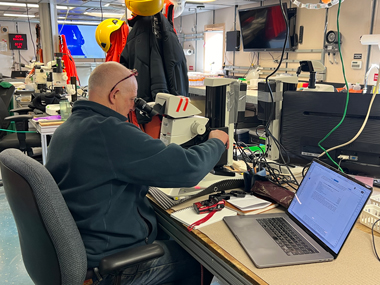

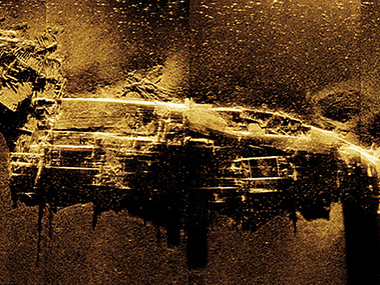
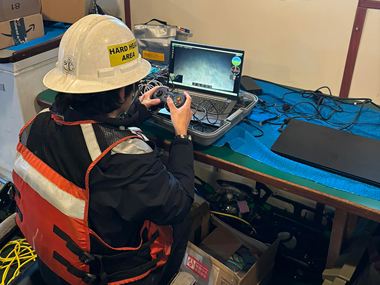
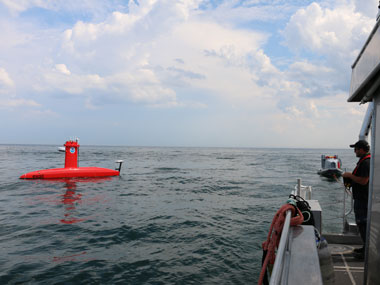
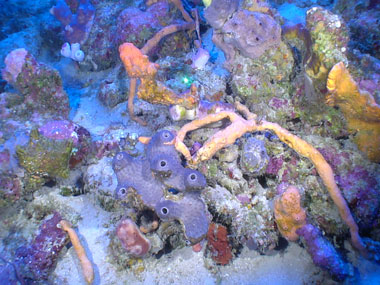
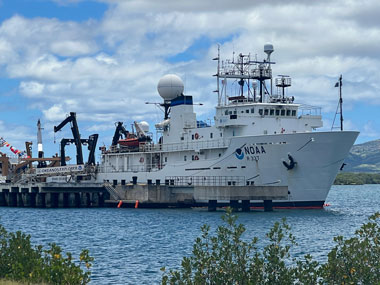
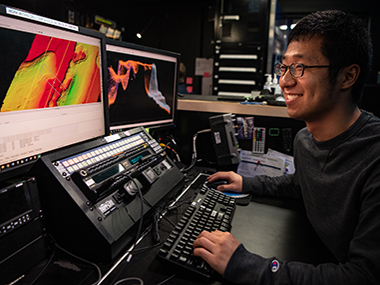
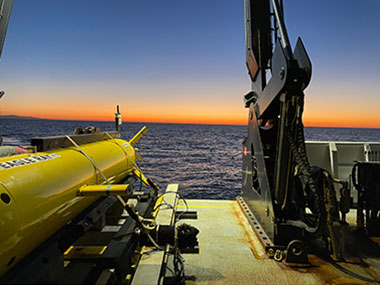
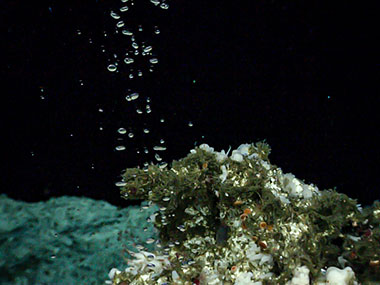
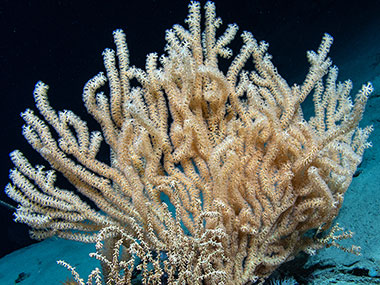
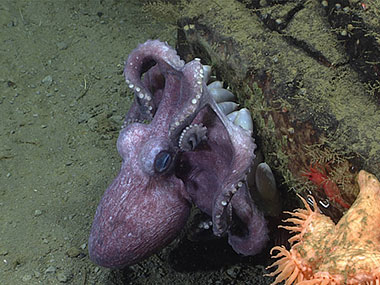


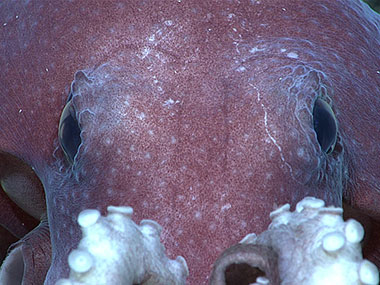


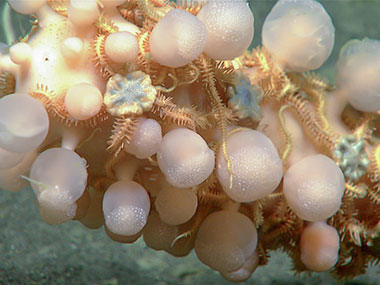
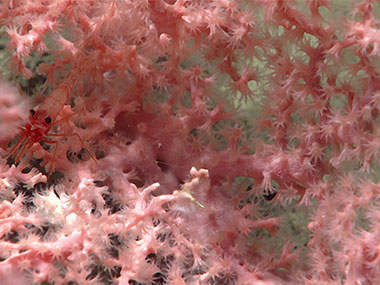


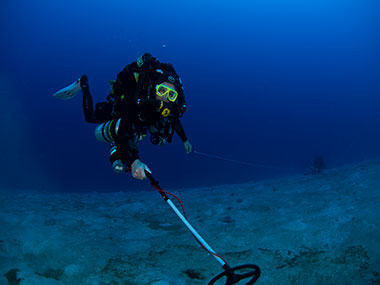

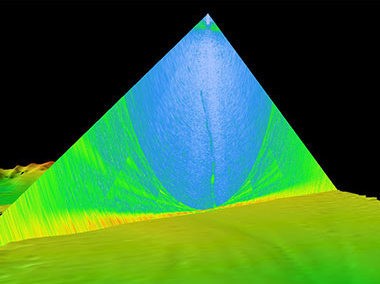
























































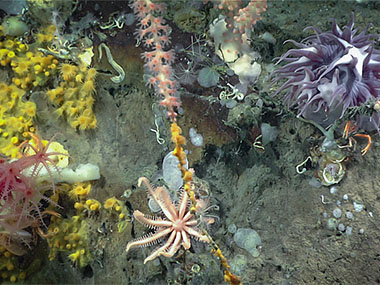



















































































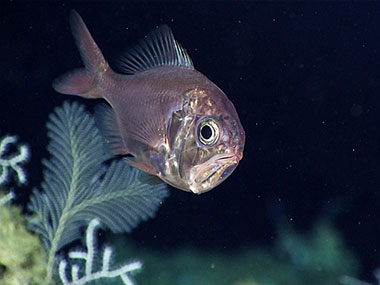


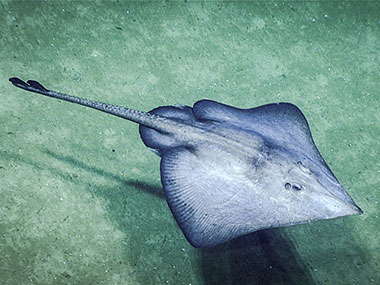




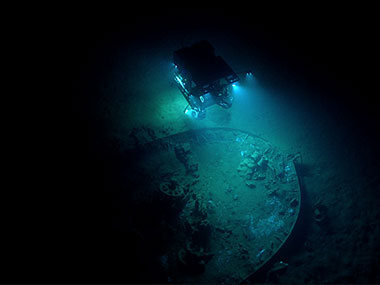


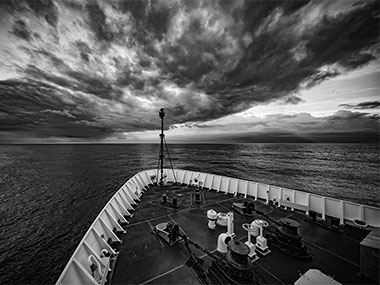






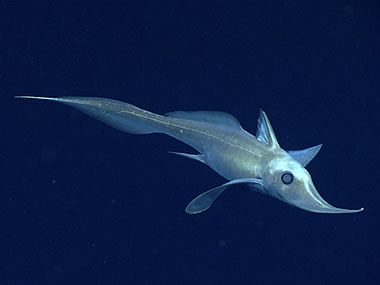








![[image] Fangtooth Fish [image] An exciting observation during today’s midwater transects, this fangtooth fish was seen at 800 meters (2,625 feet).](/okeanos/explorations/ex1708/dailyupdates/media/sept23-3-380.jpg)
![[image] Siphonophore [image] A siphonophore observed in the water column during the second full day of midwater exploration on September 22, 2017.](/okeanos/explorations/ex1708/dailyupdates/media/sept22-2-380.jpg)
![[image] Amphipods Feeding [image] The science team observed a number of amphipods (small white objects) feeding on a salp’s insides (yellow) while exploring the water column on September 19, 2017.](/okeanos/explorations/ex1708/dailyupdates/media/sept19-3-380.jpg)
![[image] Cranchiid Squid [image] Cranchiid squid observed during the Okeanos Explorer’s first-ever full day of midwater exploration.](/okeanos/explorations/ex1708/dailyupdates/media/sept17-1-380.jpg)
![[image] Lancetfish [image] Lancetfish observed during midwater transects on Dive 11 near Mahler Seamount.](/okeanos/explorations/ex1708/dailyupdates/media/sept17-2-380.jpg)
![[image] Two Sea Elephants [image] These two sea elephants were spotted on during our second full day of water column exploration.](/okeanos/explorations/ex1708/logs/sept24/media/unknown-380.jpg)
![[image] Long Antennae [image] This sergestiid shrimp is an excellent example with its long antennae reaching out to detect movement.](/okeanos/explorations/ex1708/logs/sept23/media/shrimp-380.jpg)
![[image] Larvacean [image] An oikopluerid, or larvacean inside its elaborately shaped gelatinous house.](/okeanos/explorations/ex1708/logs/sept23/media/larvacean-380.jpg)
![[image] Hatchetfish [image] This hatchetfish was spotted in the water column at a depth of 500 meters (1,640 feet) during midwater transects on September 10, 2017.](/okeanos/explorations/ex1708/dailyupdates/media/sept10-2-380.jpg)
![[image] Warty Clubfoot Jelly [image] Halicreas minimum, the warty clubfoot jelly, shown here with an amphipod along for the ride.](/okeanos/explorations/ex1708/logs/sept23/media/warty-380.jpg)
![[image] Sea Spider [image] This sea spider was observed at about 1,675 meters (5,495 feet) depth on a bamboo coral that has been colonized by yellow parazoanthids.](/okeanos/explorations/ex1708/dailyupdates/media/sept25-2-380.jpg)
![[image] Anemone [image] Anemone observed while diving at Mozart Seamount on September 21, 2017.](/okeanos/explorations/ex1708/dailyupdates/media/sept21-3-380.jpg)
![[image] Forward-facing High-definition Camera [image] The forward-facing high-definition camera is the most commonly seen view from ROV Seirios.](/okeanos/explorations/ex1708/logs/sept26/media/camera-380.jpg)
![[image] Okeanos Explorer [image] NOAA Ship Okeanos Explorer shortly before departing for the last expedition of NOAA’s Campaign to Address Pacific monument, Science, Technology, and Ocean NEeds (CAPSTONE).](/okeanos/explorations/ex1708/logs/sept9/media/okeanos-380.jpg)
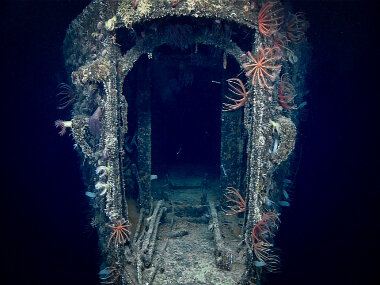
![[image] Rippled Sponge [image] This large rippled sponge, approximately four meters (13.1 feet) in length, looks to be the same animal discovered during the Okeanos Explorer 2015 Hohonu Moana expedition.](/okeanos/explorations/ex1708/dailyupdates/media/sept24-3-380.jpg)
![[image] Sibelius Seamount [image] On September 10, 2017, while exploring Sibelius Seamount, the team observed this garden of coral at a depth of 2,465 meters (8,080 feet).](/okeanos/explorations/ex1708/dailyupdates/media/sept10-1-380.jpg)
![[image] Deep-sea Lizardfish [image] Always an exciting find, this deep sea lizardfish was observed close to the shallow edge of the species depth range.](/okeanos/explorations/ex1708/dailyupdates/media/sept13-2-380.jpg)
![[image] Mussorgsky Seamount [image] At the beginning of the dive on Mussorgsky Seamount, the corals were aligned perpendicular to the current, which is the optimal position to acquire food.](/okeanos/explorations/ex1708/dailyupdates/media/sept18-1-380.jpg)
![[image] Glass Sponge [image] This glass sponge (Saccocalyx sp.) was one of many glass sponges observed throughout the dive on Mozart Seamount.](/okeanos/explorations/ex1708/dailyupdates/media/sept21-1-380.jpg)
![[image] Pink Coral [image] A pink coral (Hemicorallium sp.) observed at ~1,654 meters (5,426 feet) had a base approximately 18 centimeters (seven inches) wide, indicating a particularly old colony.](/okeanos/explorations/ex1708/dailyupdates/media/sept25-3-380.jpg)
![[image] Yellow Glass Sponge [image] This vibrant yellow glass sponge (Bolosoma sp.) was observed at a depth of 2,479 meters (8,133 feet) while exploring Sibelius Seamount.](/okeanos/explorations/ex1708/dailyupdates/media/sept10-3-380.jpg)
![[image] Feeding On Coral [image] One of many sightings during today’s dive of a seastar feeding on coral. Here you can see a Calliaster sp. sea star's tube feet feeding on bamboo coral.](/okeanos/explorations/ex1708/dailyupdates/media/sept7-1-380.jpg)
![[image] Six-gilled Stingray [image] An unusual observation of a six-gilled stingray, Hexatrygon bickelli.](/okeanos/explorations/ex1708/dailyupdates/media/sept28-2-380.jpg)
![[image] Sea Toad [image] This sea toad or coffinfish (Chaunacops species) was seen at a depth of about 3,148 meters (1.96 miles), during a remotely operated vehicle (ROV) dive at a seamount ridge, dubbed “Beach Ridge,” in the Musicians Seamount group northeast of Oʼahu, Hawaiian Islands.](/okeanos/explorations/ex1708/logs/sept12/media/img1-380.jpg)
![[image] Volcanic Ridge [image] A possible volcanic ridge extends eastward from Liszt seamount.](/okeanos/explorations/ex1708/logs/sept28/media/fig1-380.jpg)










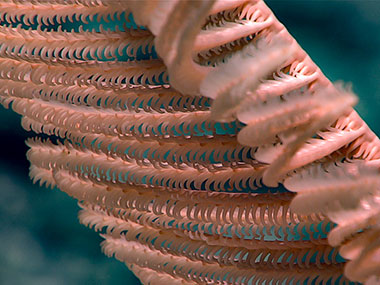
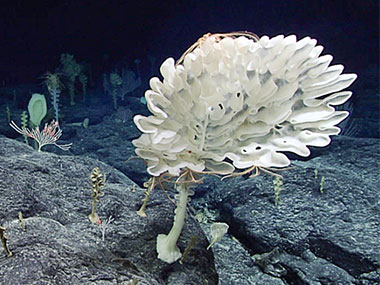










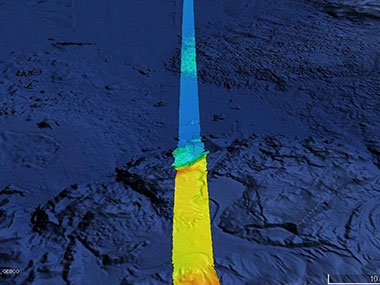










![[image] Alien Invasive Species [image] Alien Invasive Species](/explorations/17midway/logs/may9/media/structure-380.jpg)

![[image] Umbrella-shaped Pedestal [image] Umbrella-shaped Pedestal](/okeanos/explorations/ex1705/dailyupdates/media/may5-1-380.jpg)
![[image] Yellow Bamboo Coral [image] Yellow Bamboo Coral](/okeanos/explorations/ex1705/logs/may16/media/yellow-380.jpg)
![[image] Brittle Star and Bamboo Coral [image] Brittle Star and Bamboo Coral](/okeanos/explorations/ex1705/logs/may16/media/bamboo-380.jpg)
![[image] Randall's Snapper [image] Randall's Snapper](/okeanos/explorations/ex1705/logs/may6/media/randalls-380.jpg)
![[image] Sand Tiger Shark [image] Sand Tiger Shark](/okeanos/explorations/ex1705/dailyupdates/media/may12-3-380.jpg)
![[image] Batfish [image] Batfish](/okeanos/explorations/ex1705/dailyupdates/media/may7-2-380.jpg)
![[image] Lizardfish [image] Lizardfish](/okeanos/explorations/ex1705/logs/may10/media/bathysaurus-380.jpg)
![[image] Venus Flytrap Anemone [image] Venus Flytrap Anemone](/okeanos/explorations/ex1705/dailyupdates/media/may12-2-380.jpg)
![[image] Octopus Friday [image] Octopus Friday](/okeanos/explorations/ex1705/dailyupdates/media/may5-3-380.jpg)
![[image] Sea Cucumber [image] Sea Cucumber](/okeanos/explorations/ex1705/dailyupdates/media/may2-4-380.jpg)
![[image] Stars on a Sponge [image] Stars on a Sponge](/okeanos/explorations/ex1705/logs/may8/media/sponge2-380.jpg)
![[image] Hair-like Appendages [image] Hair-like Appendages](/okeanos/explorations/ex1705/logs/may7/media/cuke3-380.jpg)
![[image] Golden Crab [image] Golden Crab](/okeanos/explorations/ex1705/logs/may6/media/crab-380.jpg)
![[image] Swimming Cucumber [image] Swimming Cucumber](/okeanos/explorations/ex1705/dailyupdates/media/may6-2-380.jpg)
![[image] Potent Jellyfish [image] Potent Jellyfish](/okeanos/explorations/ex1705/logs/may9/media/jelly1-380.jpg)
![[image] Siphonophore [image] Siphonophore](/okeanos/explorations/ex1705/logs/may9/media/sipho-380.jpg)
![[image] Ctenophore [image] Ctenophore](/okeanos/explorations/ex1705/logs/may9/media/combjelly-380.jpg)
![[image] Mountain in the Deep [image] Mountain in the Deep](/okeanos/explorations/ex1705/dailyupdates/media/may17-1-380.jpg)
![[image] Kahalewai [image] Kahalewai](/okeanos/explorations/ex1705/dailyupdates/media/may3-2-380.jpg)
![[image] Jarvis Unit of PRIMNM [image] Jarvis Unit of PRIMNM](/okeanos/explorations/ex1705/background/plan/media/seamount-380.jpg)





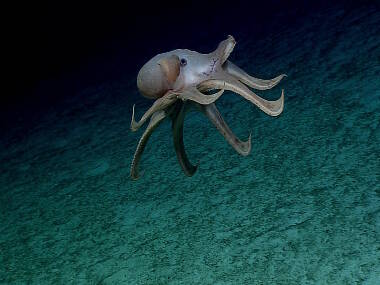
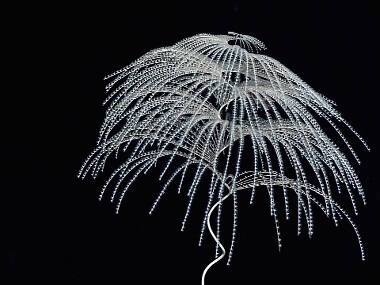


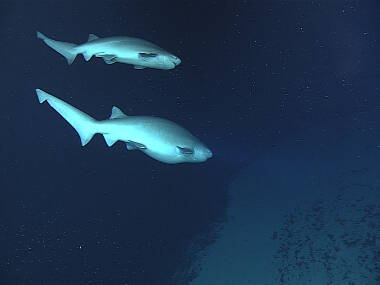


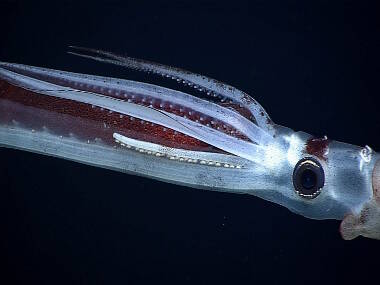


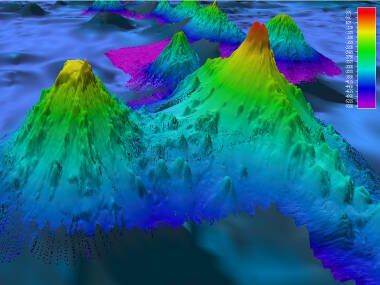
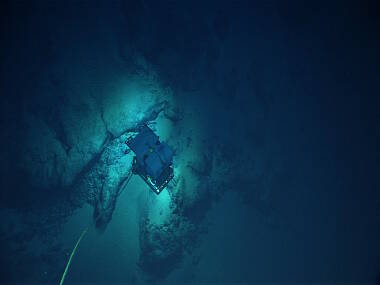

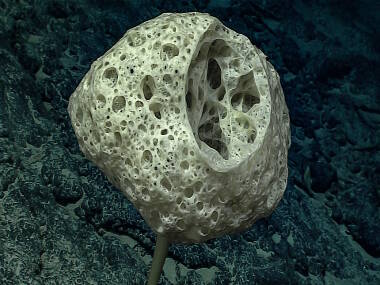











![[image] XBT Cast [image] XBT Cast](/okeanos/explorations/ex1606/logs/aug12/media/mappingteam2-380.jpg)
![[image] High-Density Coral Community [image] High-Density Coral Community](/okeanos/explorations/ex1606/dailyupdates/media/aug3-380.jpg)
![[image] Pillow Lava [image] Pillow Lava](/okeanos/explorations/ex1606/logs/aug13/media/pillow-380.jpg)
![[image] Sixgill Shark [image] Sixgill Shark](/okeanos/explorations/ex1606/dailyupdates/media/aug13-380.jpg)
![[image] Squat Lobster [image] Squat Lobster](/okeanos/explorations/ex1606/logs/aug9/media/1606-chirostylid-squat-lobster-380.jpg)

![[image] Sea Toad [image] Sea Toad](/okeanos/explorations/ex1606/dailyupdates/media/aug6-1-380.jpg)
![[image] Summary Map [image] Summary Map](/okeanos/explorations/ex1606/logs/summary/media/1606-summary-map-380.jpg)
![[image] Mapping Coverage Completed [image] Mapping Coverage Completed](/okeanos/explorations/ex1606/logs/aug12/media/fig5c-380.jpg)





























